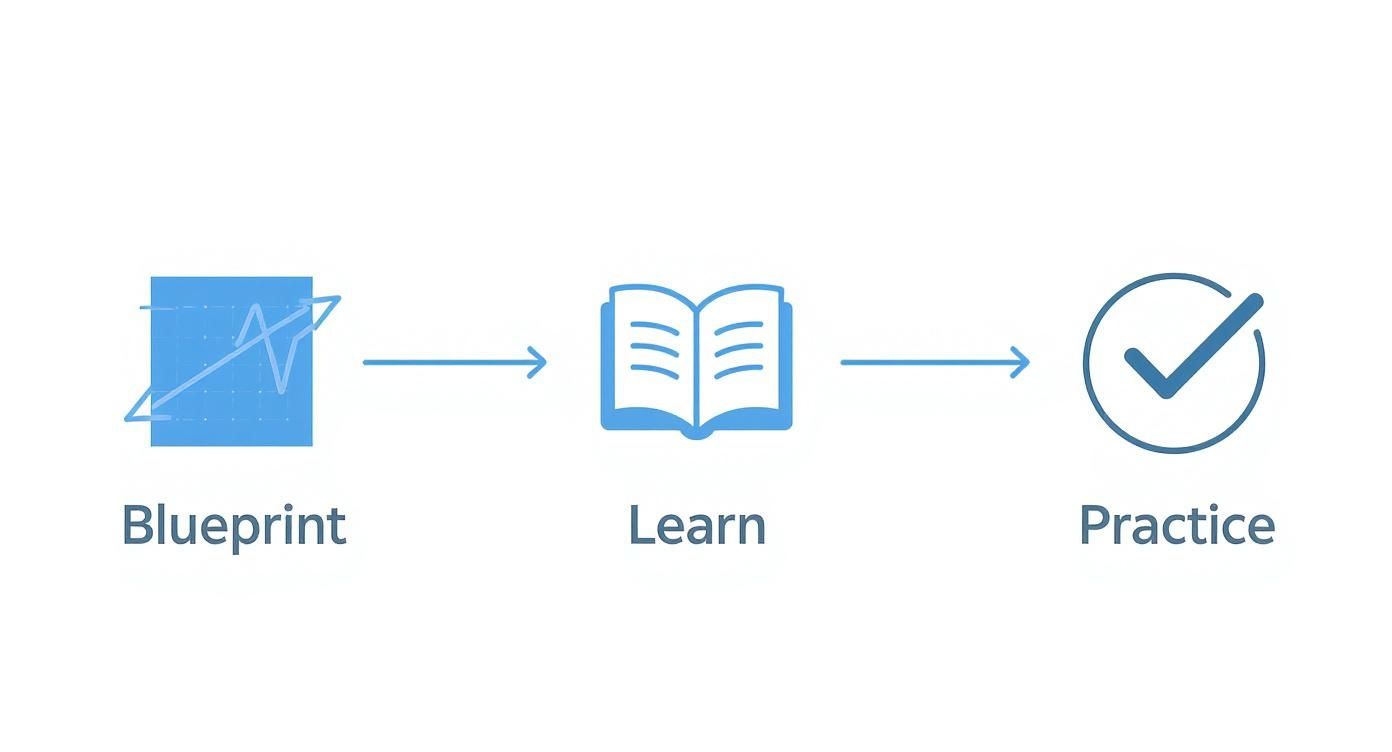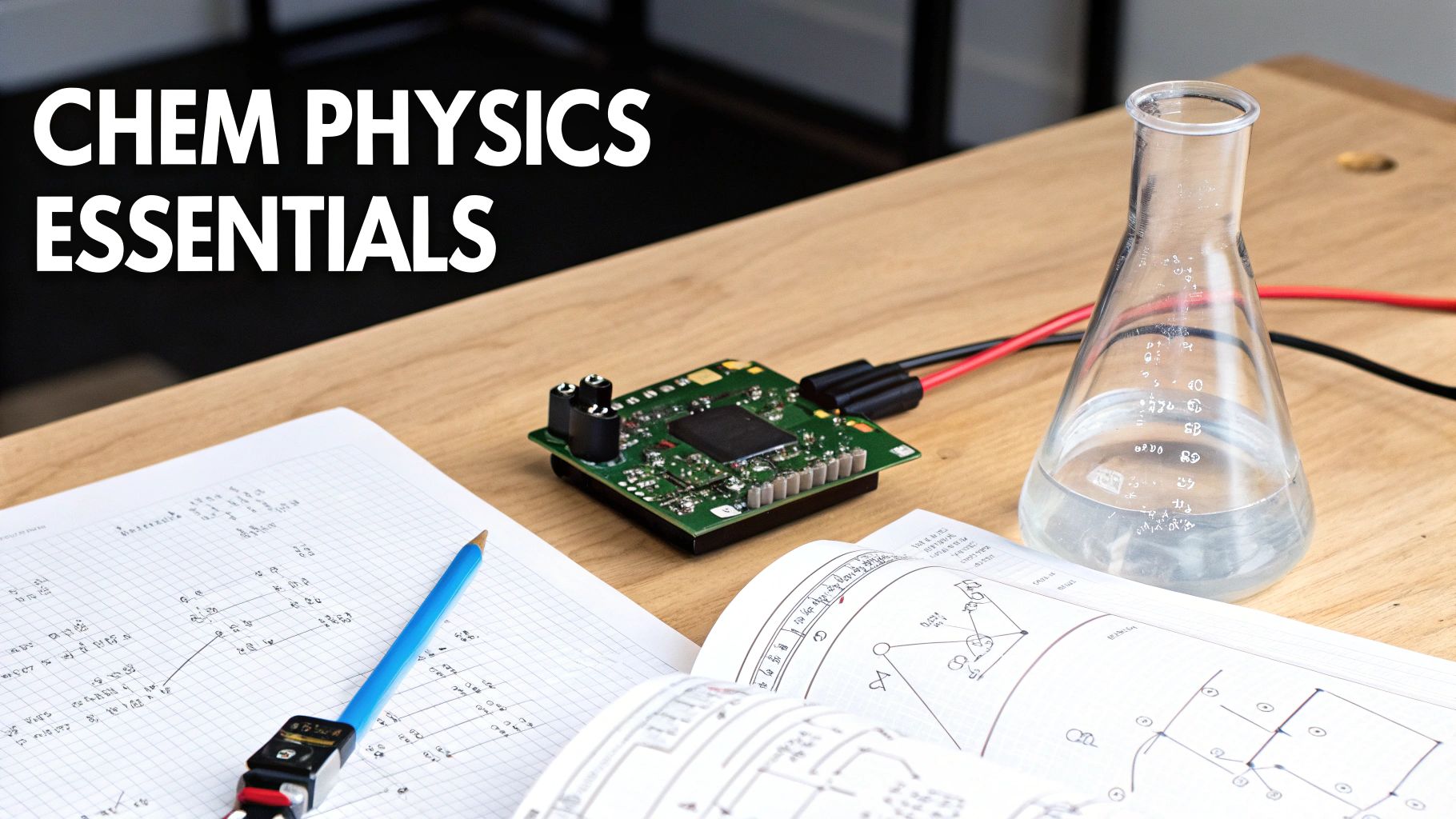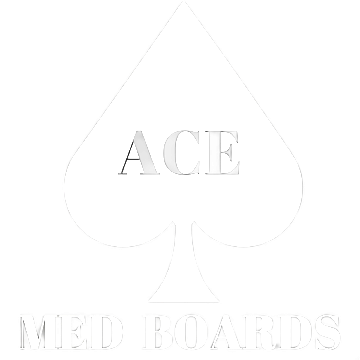An effective MCAT content review isn’t about brute-force memorization. It’s a strategic process of building a deep, practical understanding of core concepts so you can apply them under pressure. A solid plan has to balance breadth with depth, weaving in principles like active recall from day one to make sure the information actually sticks.
Your Blueprint for Effective MCAT Content Review
Staring at the sheer volume of MCAT topics can feel completely paralyzing. Where do you even start? The key isn't just to crack open a book and start reading; it's to build a strategic framework that guides every single study session. Think of it like creating a blueprint before you build a house—it ensures every action has a purpose and contributes to a stable final structure.
This approach shifts you from being a passive learner, just consuming facts, to an active participant in your own education. Instead of just reading about glycolysis, you’ll learn to draw the pathway from memory, explain how it’s regulated, and predict how an enzyme deficiency would play out in a patient scenario. This is the level of critical thinking the MCAT demands.
Before we dive into the section-by-section breakdown, let's get a bird's-eye view of what you're up against.
Here is a quick summary of the core content areas, question counts, and timing for each part of the MCAT.
MCAT Section Breakdown At A Glance
| MCAT Section | Primary Subjects | Number of Questions | Time Allotted (minutes) |
|---|---|---|---|
| Chemical and Physical Foundations of Biological Systems | General Chemistry, Organic Chemistry, Physics, Biochemistry | 59 | 95 |
| Critical Analysis and Reading Skills (CARS) | Humanities, Social Sciences | 53 | 90 |
| Biological and Biochemical Foundations of Living Systems | Biology, Biochemistry, Organic Chemistry | 59 | 95 |
| Psychological, Social, and Biological Foundations of Behavior | Psychology, Sociology, Biology | 59 | 95 |
Understanding this structure helps you appreciate the test's scope and the stamina required. Now, let’s get into the strategy behind mastering the content.
Structuring Your Content Review Phase
A powerful MCAT content review is built on a few non-negotiable principles. Integrating these from the very beginning will make your study time far more productive and a lot less stressful.
- Active Recall: Stop just re-reading your notes. Actively test yourself by trying to pull information from your brain without looking. This can be as simple as explaining a concept out loud to an empty room or grinding through flashcards.
- Spaced Repetition: This is your secret weapon against the "forgetting curve." By reviewing topics at increasing intervals, you force information from your short-term memory into long-term storage where it belongs.
- High-Yield Focus: Let’s be real—not all content is created equal. You have to prioritize the topics and concepts that show up most frequently on the exam to get the best return on your time investment.
A huge piece of this puzzle is mastering how you capture and organize all this information. For a deeper dive, check out these tips for improving your note-taking skills. A well-organized system for your notes and, more importantly, your missed questions is absolutely fundamental.
The infographic below shows the simple, three-stage flow of an effective review process.

This visual drives home the point: your blueprint guides your learning, which is then constantly tested and sharpened through practice.
Avoiding Common Pitfalls
So many students fall into the same predictable traps. One of the biggest is getting stuck in the content review phase and not moving on to practice questions quickly enough. Your study plan must integrate both from early on. To get this balance right, check out our guide on creating an effective https://acemedboards.com/mcat-study-schedule/.
The MCAT has come a long way since it first appeared in 1928. Today, it’s a grueling 7.5-hour exam covering four distinct sections. With the average score for medical school matriculants hovering around 511.7, you need a disciplined approach that avoids passive learning and content overload. Your goal is to build a foundation so solid you can handle any curveball the test throws at you.
Mastering the Bio and Biochem Section

Let's be honest: the Biological and Biochemical Foundations of Living Systems section is the content beast of the MCAT. It’s where countless facts, pathways, and systems all crash together. Trying to just memorize everything is a surefire recipe for burnout.
The secret isn’t knowing every single detail. It’s about learning to see the connections that turn a pile of isolated facts into a single, interconnected system.
Think of it like learning a new city. You could try to memorize a list of every single street name—a terrible idea. Or, you could learn the main highways, understand how the big neighborhoods connect, and then fill in the smaller streets as needed. That second approach is how you actually learn to get around, and the same logic works perfectly here. Your job is to map the major highways of biology.
For example, understanding glycolysis isn't just about memorizing ten enzymes. It’s about seeing it as a central energy hub that plugs directly into the citric acid cycle, amino acid metabolism, and even endocrinology through insulin signaling. That web of connections is what the MCAT really tests.
Focusing on High-Yield Biological Systems
While biology is massive, the MCAT consistently hammers a few key areas. Your MCAT content review for this section has to prioritize these systems, not just as standalone topics, but as interacting parts of a complex machine—the human body.
These are the systems that demand your full attention:
- Metabolic Pathways: This is the absolute heart of biochemistry. Get comfortable with glycolysis, gluogenesis, the citric acid cycle, and oxidative phosphorylation. You need to know the key regulatory enzymes and how hormones like insulin and glucagon flip the on/off switches.
- Enzyme Kinetics: Don't just memorize the Michaelis-Menten equation. You have to understand what Vmax and Km actually represent. Think of Km as an enzyme's "affinity" or "attraction" for its substrate. A low Km means high attraction, like a really strong magnet.
- Organ Systems: Prioritize the big three: cardiovascular, endocrine, and nervous systems. They show up constantly because they're the body’s main communication and transport networks. Learn how they talk to each other—for instance, how the nervous system triggers the endocrine system (epinephrine release) to affect the cardiovascular system (increased heart rate).
A core skill for this section is data interpretation. The MCAT won't just ask you to recall a fact; it will present a graph from a fictional experiment and expect you to apply your foundational knowledge to analyze the results and draw a conclusion.
Decoding Experimental Passages
Many students get intimidated by the dense, research-style passages in this section. The trick is to develop a system for breaking them down. Don't get lost in the jargon; focus on spotting the core parts of the scientific method right there in the passage.
Before you even glance at the questions, do a quick scan to identify these five things:
- The Big Question: What problem are these scientists trying to solve?
- The Hypothesis: What did they predict would happen?
- The Methods: What did they actually do? Pay close attention to the control group and the independent and dependent variables.
- The Results: Look at the figures and tables. What are the obvious trends in the data?
- The Conclusion: How did the scientists explain what they found?
This structured approach stops you from getting bogged down in tiny details and helps you see the big picture fast. By practicing this method, you'll be able to pull out the exact information you need to answer questions with confidence. For more strategies on prioritizing information, check out our detailed guide to MCAT high-yield topics. Focusing on what matters most is absolutely critical for success.
Conquering the Chem and Physics Section

Let's be honest: the Chemical and Physical Foundations of Biological Systems section can feel like the final boss of MCAT content review. For many premeds, it’s a terrifying list of abstract formulas and physics laws that have to be crammed into their brains.
That's a trap. Real success on C/P doesn't come from brute-force memorization of every equation. It comes from deeply understanding the fundamental principles behind them and, more importantly, seeing how they apply to living systems.
The trick is to start thinking like the MCAT test-makers. Reframe every concept through a biological lens. Fluid dynamics isn't just a random chapter in a physics textbook; it's the very system that governs blood flow through your arteries. This shift in perspective is what makes abstract ideas click and stick with you on test day.
Think of the human body as the most complex machine you'll ever study. Chemistry and physics are its instruction manual. Your job is to learn how to read that manual so you can troubleshoot the biological problems presented in the passages.
Connecting Physics Concepts to Living Systems
The MCAT will almost never ask you to solve a physics problem in a vacuum. The questions are almost always wrapped in a biological or clinical story. Your content review needs to reflect this from day one.
Focus on building these high-yield connections:
- Fluid Dynamics: Don't just learn Bernoulli's equation. Apply it directly to the circulatory system. How does a blood vessel's diameter impact pressure and velocity? What physically happens when plaque buildup (stenosis) narrows an artery?
- Circuits & Electromagnetism: This isn't about building a radio. It's about understanding how your nervous system fires. Picture a neuron's axon as a biological circuit, with ion channels as resistors and the cell membrane acting as a capacitor.
- Thermodynamics: These laws govern every single metabolic reaction in your body. When you study concepts like enthalpy and entropy, immediately connect them to processes like ATP hydrolysis or how a protein folds into its final shape.
By constantly asking yourself, "How does this apply to the human body?" you turn rote memorization into a much deeper, more intuitive understanding. This is the approach that separates the high-scorers from everyone else.
Mastering Chemistry Through Application
The general and organic chemistry topics on the MCAT are tied to biological function in the same way. It's easy to get lost in the weeds, trying to memorize complex reaction mechanisms you'll likely never see on the exam. Instead, focus on the functional role of chemistry in biological systems.
A classic mistake is spending weeks on niche O-chem reactions. The MCAT is far more interested in your understanding of acid-base chemistry, bonding, and stereochemistry because these ideas directly explain how molecules like amino acids and drugs actually behave inside the body.
Make these core areas your priority:
- Acid-Base Chemistry: You absolutely must have a rock-solid grasp of buffers, pH, and pKa. The bicarbonate buffer system in the blood is a classic, high-yield topic that beautifully blends chemistry, biology, and physiology.
- Kinetics & Equilibrium: These concepts are the bedrock of enzyme function and metabolic control. Truly understanding Le Châtelier's principle will help you explain how the body responds to all sorts of physiological stress.
The level of integration here is what makes the MCAT such a respected exam. It's not just a hurdle for U.S. med schools; it's also used for admissions in Canada, Australia, and the Caribbean. This international adoption shows just how effective the test is at finding students with the scientific reasoning skills needed to become a great physician. If you want to learn more about the exam's design and global reach, you can explore the details of the Medical College Admission Test.
Ultimately, your C/P review should be all about building bridges. Every physics law and chemical principle is a tool. Your goal is to know these tools so well that you can confidently pick the right one to solve any biological puzzle the MCAT throws your way.
Navigating the Psych and Soc Section
The Psychological, Social, and Biological Foundations of Behavior section feels like the odd one out on the MCAT, and for good reason. It is. Success here isn’t about running complex calculations or mapping out multi-step reactions; it’s a game of precision. To do well, you need a rock-solid grasp of specific terminology and the skill to apply dense theoretical frameworks to real-world situations.
A ton of students underestimate this section, writing it off as simple vocabulary memorization. That's a huge mistake. The MCAT won’t just ask you for a definition. It’s far more likely to throw a research passage at you describing a social experiment and then ask you which sociological theory best explains what happened.
Think of yourself as a detective. The passage is your case file, full of clues. Your knowledge of psychological and sociological models? Those are your "suspects." It’s your job to solve the case. Is the behavior in the passage a clear-cut example of conflict theory, or are you looking at classic symbolic interactionism? Knowing the difference is everything.
Mastering Key Theories and Frameworks
Your MCAT content review for Psych/Soc has to be built on a deep understanding of the major theories. These aren't just names to cram into your brain; they're the lenses you'll use to analyze human behavior.
- Functionalism: This theory looks at society as a complex system where all the parts work together to keep things stable. Think of society as a living organism—every institution, like family or education, has a specific job that helps keep the whole thing alive and running smoothly.
- Conflict Theory: This is the polar opposite of functionalism. It frames society as an arena of inequality that sparks conflict and drives change. The focus here is on the power struggles between different groups—think class, gender, and race—all competing for the same limited resources.
- Symbolic Interactionism: This is a micro-level theory, zeroing in on social interactions in very specific situations. It argues that society is really just the sum of all our everyday, person-to-person interactions. Consider how a simple handshake is just a gesture, but its meaning (a symbol) can change dramatically across different cultures.
- Social Constructionism: This theory dives into how we, as individuals and groups, literally create our own reality. It points out that things like money or the concept of "justice" have no real, intrinsic value. We, as a society, have just collectively agreed to give them value.
A classic trap is mixing up terms that sound alike. For instance, telling the difference between self-serving bias, confirmation bias, and belief perseverance requires way more than a surface-level definition. To really lock these in, come up with your own concrete examples for each one.
Dissecting Research-Based Passages
The Psych/Soc section is packed with passages that read like condensed research papers. Being able to break these down quickly is a make-or-break skill. The trick is to not get lost in the weeds. Train yourself to spot the core components of the study right away.
When you hit a new passage, your first mission is to find the experimental backbone:
- Hypothesis: What exactly were the researchers trying to prove?
- Methodology: Who were the participants? What was the independent variable (the thing they changed) and the dependent variable (the thing they measured)?
- Key Findings: What were the main results? These are often hiding in a chart or graph.
- Conclusion: What was the researchers' takeaway from their findings?
By systematically breaking down every passage like this, you create a mental blueprint of the experiment. This structure helps you cut through the confusing jargon and focus on what you actually need to answer the questions. It's a methodical approach that builds the confidence you need to handle any curveball the MCAT throws, turning what could be a confusing section into one of your biggest strengths.
Excelling in the CARS Section

Ah, the Critical Analysis and Reasoning Skills (CARS) section. This is the great equalizer of the MCAT. It's the one part of the exam where you can't rely on flashcards or memorized formulas. Your success boils down to one thing: your ability to break down dense, often confusing passages and figure out what an author is truly trying to say—all under a crushing time limit.
A lot of students fall into the trap of thinking they just need to read faster. That’s a huge mistake. CARS isn't a speed-reading competition; it’s a test of strategic thinking. The real skill is learning to read with purpose, pulling out the core message without getting lost in the weeds of complex vocabulary or niche details.
Try to think of each CARS passage as a one-on-one conversation. Your goal isn't just to hear the words, but to understand the author's tone, their agenda, and the deeper meaning behind their argument. Are they trying to convince you of something? Are they just informing you, or are they tearing down someone else's idea? Nailing this down is your first and most critical task.
A Methodology for Deconstructing Passages
You can't just dive into a CARS passage and hope for the best. That’s like trying to navigate a maze blindfolded. To consistently score well, you need a repeatable, systematic approach for every single passage you encounter.
Here’s a proven, step-by-step process that works:
- The First Pass: Read through the passage at a natural, comfortable pace. Don't stress about memorizing details. Your only job on this first read is to find the main idea—the author's central thesis.
- Highlight Key Arguments: As you read, make a mental note of the sentences that directly state the author's opinion or the main points they use to back it up. This helps you build a "skeleton" of the passage's logic.
- Pinpoint the Tone: Once you finish, ask yourself: what’s the author’s attitude here? Are they passionate and persuasive, or are they critical and skeptical? Maybe they're just neutral. Understanding their tone is a massive clue for answering many of the questions.
This structured method keeps you from getting bogged down and forces you to focus on the big-picture ideas, which is what most CARS questions are really testing.
Understanding CARS Question Types
Not all CARS questions are the same. They’re designed to probe different layers of your reasoning, and recognizing the type of question you're up against is half the battle. The AAMC officially groups them into three core skill sets.
- Foundations of Comprehension: These are the most straightforward questions. They basically ask, "What did the author explicitly say?" or "What does this word mean in this specific context?"
- Reasoning Within the Text: These questions ask you to connect the dots between different ideas presented in the passage. They test if you can see how an author’s claims relate to their evidence.
- Reasoning Beyond the Text: These are the toughest nuts to crack. They ask you to take the author's logic and apply it to a completely new situation or to consider how new information would impact their argument.
A classic trap that test-makers love to set is offering an answer choice that is a true statement in the real world but is not actually supported by the passage itself. Your answer must always come directly from the text—never from your own outside knowledge.
The MCAT is graded on a scale from 118 to 132 for each section. While a competitive total score is often around 511, the weight of the CARS score varies by medical school. For many admissions committees, it’s a vital sign of your ability to handle complex information, a skill every future doctor needs.
Ultimately, mastering CARS comes down to building mental stamina and razor-sharp analytical habits. It takes consistent, deliberate practice to develop the intuition needed to cut through the noise and find the author's true message. For more in-depth strategies, check out our guide on how to improve your CARS score on the MCAT. With the right approach, you can turn what seems like your most daunting section into one of your biggest strengths.
Choosing the Best MCAT Content Review Resources
Let's be honest: navigating the sea of MCAT prep materials can feel just as daunting as tackling the content itself. Choosing the right tools for your learning style isn't just about preference; it’s a critical strategic decision that will shape your entire MCAT content review. Picking the wrong resources can lead to countless wasted hours and a ton of frustration.
Think of it this way: you wouldn't use a hammer to drive a screw. In the same way, the book set that worked wonders for your friend might be a terrible fit for you. The goal is to build a personalized arsenal of books, question banks, and digital tools that play to your strengths while directly attacking your weaknesses.
Selecting Your Core Content Books
Your primary review books will be the foundation of your content knowledge. The two biggest names in the game are Kaplan and The Princeton Review, and each brings a completely different philosophy to the table. Understanding their approaches is the first step to choosing your home base for studying.
I've put together a quick comparison of the most popular MCAT review book sets to help you see the key differences at a glance.
Comparison of Popular MCAT Review Books
This table breaks down the top MCAT review book sets, looking at their approach to content depth, practice questions, and overall style.
| Resource (Book Set) | Best For | Key Strengths | Potential Drawbacks |
|---|---|---|---|
| Kaplan | Students who need a very thorough, detailed review of all content areas. | Exceptionally comprehensive content; strong in sciences and biochemistry. | Can be overly detailed, sometimes going beyond the MCAT's scope. |
| The Princeton Review | Students who prefer a focus on high-yield topics and test-taking strategies. | Excellent at highlighting what's most important; strong CARS strategies. | May be less detailed in certain science topics than Kaplan. |
Ultimately, there's no single "best" set here. Kaplan is often the go-to for students with weaker science foundations who need to build their knowledge from the ground up. On the other hand, The Princeton Review tends to attract students who want to double down on strategy and efficiency.
Integrating Essential Practice Resources
Content review without practice is like learning to swim by reading a book—it’s useless when it comes time to perform. Question banks are where you translate that theoretical knowledge into the ability to actually answer MCAT-style questions. Two resources are considered non-negotiable by pretty much every high-scorer.
- AAMC Official Prep Materials: This is the undisputed gold standard. Since the AAMC writes the actual MCAT, their practice questions, section banks, and full-length exams are the most representative materials you can get your hands on. These should be the centerpiece of your practice.
- UWorld: Famous for its incredibly challenging questions and outstandingly detailed explanations, UWorld is the perfect sidekick for your content review phase. It’s brilliant for diagnosing knowledge gaps and forcing you to learn the underlying concepts, not just memorize an answer.
The most effective study plans don't save all the practice for the end. They integrate UWorld questions from day one, using them to actively test the material you're learning from your review books.
Leveraging Digital Tools for Efficiency
Finally, the smartest students supplement their core resources with digital tools that optimize the learning process. Two standouts are Anki and Khan Academy, both of which are free and incredibly powerful.
Anki is a flashcard program that uses a spaced repetition algorithm to burn facts into your long-term memory. It’s perfect for the brute-force memorization of things like amino acids, metabolic pathway enzymes, and psych/soc terms.
Meanwhile, Khan Academy offers a massive library of videos and practice passages created in partnership with the AAMC. This makes it a fantastic, official resource for clarifying any topics that leave you scratching your head. By combining these resources, you can build a flexible, powerful, and surprisingly budget-friendly study plan.
Common Questions About MCAT Content Review
As you start mapping out your MCAT prep, a bunch of questions are bound to pop up. Getting straight answers to these common hurdles can clear away a lot of the stress and confusion, letting you focus on what really matters: mastering the material.
Think of this section as your strategic guide to the logistics of MC. You need a game plan for the content, but you also need one for your time, your resources, and your sanity. Let's tackle some of the biggest questions students have.
How Long Should My Content Review Phase Really Last?
There's no magic number, but for most students studying full-time, a solid content review phase lasts three to four months. A battle-tested strategy is to spend the first two or three months diving deep into the content while sprinkling in practice questions to keep yourself honest.
This initial period is all about building your foundation of knowledge. Then, in that final month, you need to make a dramatic shift. The focus should pivot almost entirely to full-length practice exams and ruthlessly targeted review of the weak spots those exams reveal. If you're juggling a job or classes, stretch this timeline out to five or even six months to avoid burning out.
Should I Bother Using Anki for Content Review?
Yes. Absolutely, one hundred percent. Using Anki isn't just a good idea; it's a strategic advantage. It automates two of the most powerful learning principles known to science: active recall and spaced repetition. These aren't just buzzwords—they're proven methods for locking information into your long-term memory.
Anki is a beast for memorizing the mountain of discrete facts, formulas, and vocabulary you'll face in the Psychology/Sociology and Biology/Biochemistry sections. But it's a supplement, not a replacement for true understanding.
Here’s how to use it right: Learn the concepts first from your review books, videos, and practice questions. Then, use Anki to hammer that information home. It works best as a reinforcement tool, ensuring you’re not just memorizing isolated facts but connecting them to the bigger picture you're already building.
When Is the Right Time to Start Full-Length Practice Exams?
You should take your first full-length exam right at the beginning of your studies. Call it a diagnostic. It gives you a brutally honest baseline score and shines a spotlight on your strengths and weaknesses from day one, which helps you prioritize your early content review.
After that initial reality check, start weaving in full-lengths about one to two months into your prep, maybe one every couple of weeks. But when you hit the final four to six weeks before your test date, it's time to ramp up. You need to be taking at least one full-length exam per week. This isn't just about content; it's about building the mental stamina and pacing you need to survive the real thing.
Feeling like you're drowning in content and need a lifeline? The expert tutors at Ace Med Boards build personalized study plans that attack your specific weaknesses and help you hit your goal score. Schedule your free consultation today and see what a difference one-on-one guidance can make.
